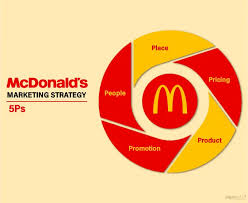Introduction
The marketing mix, often referred to as the 4Ps (product, price, place, and promotion), is a fundamental concept in marketing that helps businesses strategize and position their products effectively. In the food industry, the marketing mix plays a crucial role in determining the success of a brand. This case study explores how McDonald’s, one of the world’s leading fast-food chains, employs the marketing mix to maintain its market position and attract a broad customer base, with a focus on comparing the latest financial data with previous performance.
Product
McDonald’s offers a wide variety of products tailored to meet the tastes and preferences of its global customer base. The core product line includes hamburgers, cheeseburgers, chicken sandwiches, French fries, salads, breakfast items, soft drinks, shakes, and desserts.
Product Adaptation
McDonald’s adapts its menu to local tastes and cultural preferences. For example:
– In India, where a significant portion of the population is vegetarian, McDonald’s offers the McAloo Tikki burger and the Paneer Wrap.
– In Japan, seasonal items such as the Teriyaki Burger and Ebi Filet-O (shrimp burger) cater to local tastes.
Product Innovation
McDonald’s continuously innovates its product offerings to stay relevant and competitive. The introduction of healthier options like McWrap, premium salads, and fruit smoothies caters to the health-conscious segment of the market.
Value Pricing
McDonald’s uses value pricing to attract price-sensitive customers. The Dollar Menu (now the $1, $2 $3 Dollar Menu) offers a range of products at low prices, ensuring affordability.
Bundle Pricing
Value meals or combo meals offer bundled products at a reduced price compared to purchasing items individually. This strategy not only increases the perceived value but also encourages customers to buy more.
Place
McDonald’s has an extensive global presence with over 38,000 locations in more than 100 countries. The company employs a strategic location strategy to ensure accessibility and convenience for its customers.
Franchise Model
The franchise model enables McDonald’s to expand rapidly while maintaining consistency in service and product quality. Approximately 93% of McDonald’s restaurants are operated by independent franchisees.
Delivery and Digital Channels
To adapt to changing consumer behavior, McDonald’s has embraced digital transformation. The McDelivery service, in partnership with platforms allows customers to order food online and have it delivered to their doorstep. The McDonald’s app enhances the customer experience by offering mobile ordering, promotions, and loyalty rewards.
Advertising
McDonald’s invests heavily in advertising across various media channels, including television, radio, print, and digital. Iconic campaigns like “I’m Lovin’ It” resonate with customers globally and reinforce brand identity.
Public Relations
McDonald’s engages in public relations activities to maintain a positive brand image and connect with the community. Initiatives like the Ronald McDonald House Charities provide support to families with sick children, demonstrating the company’s commitment to social responsibility.
Financial Performance
McDonald’s marketing mix has significantly contributed to its financial success. A comparison of the latest financial data with previous performance highlights the impact of the marketing mix strategies.
Revenue
– 2022: McDonald’s reported global revenue of $23.18 billion, an increase of 10.9% from 2021.
– 2021: The company reported global revenue of $20.91 billion, showing a recovery from the pandemic’s impact.
Net Income
– 2022: McDonald’s reported a net income of $7.55 billion, an increase of 9.8% from 2021.
– 2021: The net income was $6.87 billion, reflecting strong financial performance post-pandemic.
Same-Store Sales Growth
– 2022: McDonald’s reported a global same-store sales growth of 10.5%, driven by strong performance in both the U.S. and international markets.
– 2021: Same-store sales growth was 7.5%, indicating a robust recovery and continued growth momentum.
Digital Sales
– 2022: Digital sales accounted for over 25% of McDonald’s total revenue, reflecting the success of its digital transformation strategy.
– 2021: Digital sales were approximately 20% of total revenue, showing significant growth in online and app-based orders.
Conclusion
The marketing mix is a critical framework that McDonald’s effectively utilizes to maintain its position as a global leader in the fast-food industry. By continuously innovating its product offerings, implementing strategic pricing, ensuring convenient locations, and employing diverse promotional strategies, McDonald’s successfully meets the needs and preferences of its diverse customer base. The comparison of the latest financial data with previous performance illustrates the effectiveness of McDonald’s marketing mix in driving financial success and sustaining competitive advantage in the dynamic food industry.
All reactions:
6868









